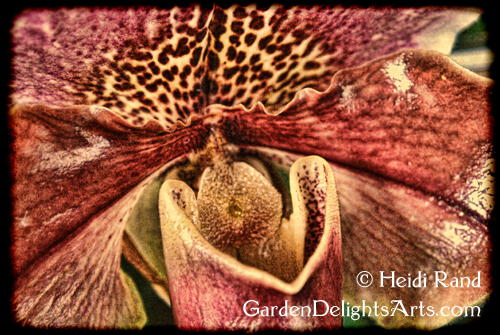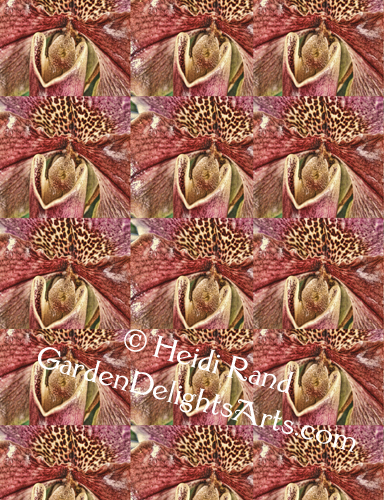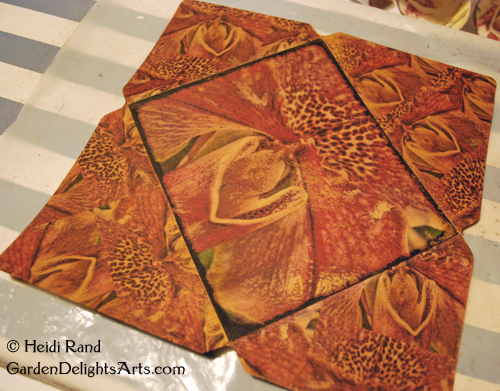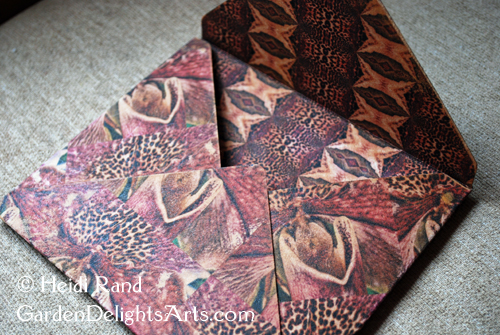Ah, isn’t a thrill to get your hands on a new art product? Playing around to figure out its best qualities, how to use it with other products and with your images and designs … doesn’t that get your creative juices flowing?
I got a roll of natural color kraft•tex, from C&T Publishing (black and white coming soon). C&T describes kraft•tex as a “tough, touchable new paper that combines the best of leather and fabric.” You can sew, and even wash it!
I’m a bit mail-art obsessed recently, so I decided to make a clutch purse in an envelope design. Rather than print directly onto the kraft•tex I wanted to try it with Transfer Artist Paper (TAP). Transfers usually work best on white or very light backgrounds, and I thought I’d check out how well the natural tan color of the kraft•tex would take a transfer.
I spent a blissful day last weekend photographing orchids at the Pacific Orchid Exposition, and got a striking closeup of a paphiopedelum, which I altered for a painterly effect. I thought the rich colors would blend nicely with the kraft•tex. This is the image:

I re-sized it to fit onto the front of the purse and flipped horizontally so it would transfer with the orientation I wanted – this matters most for text, of course. To fill the rest of the sheet of TAP I designed a kaleidoscope from the original image and tiled it to transfer to the inside of the purse. This is the single tile:

Next, what about the back? The four flaps of the envelope overlap, so I didn’t want to use a single image. I took a portion of the original image, resized it smaller, and tiled it onto a full sheet.
 Finally it was time to transfer! TAP works best at the highest iron setting that the surface you’re ironing onto can withstand, so I set it on linen. Taking the front piece first, I cut out closely around the image, placed it face down onto the kraft•tex, covered it with parchment paper to protect the iron, and slowly circled around the entire piece with the iron.
Finally it was time to transfer! TAP works best at the highest iron setting that the surface you’re ironing onto can withstand, so I set it on linen. Taking the front piece first, I cut out closely around the image, placed it face down onto the kraft•tex, covered it with parchment paper to protect the iron, and slowly circled around the entire piece with the iron.

I was very happy with how it turned out, so moved on to transfer the inside piece.

Small details and lines in an image never show up as well in a transfer as on a direct print, but I have come to accept that as the tradeoff for the ease of using a transfer rather than treating a surface for a good direct print.
Finally, for the back, I cut pieces of the TAP sheet roughly to size and transferred them one at a time to each flap.

Drum roll please .. here’s the front of my kraft•tex Paphiopedilum Orchid Envelope Purse!

And the back:

I’m plotting what kind of closure to use. Probably something involving fabric. Stay tuned!
Oh – and I’ll be demonstrating TAP and Lutradur (and, it turns out they want me to also demo kraft•tex) on Saturday March 15th at Flax Art & Design in San Francisco. Free! Click here to read my blog post with all of the details.
Have you used a new art product lately? Please show and tell!





 I slid the paper into the printer and crossed my fingers that it would be sturdy enough not to crumple up. Phew — it went through with no problem at all!
I slid the paper into the printer and crossed my fingers that it would be sturdy enough not to crumple up. Phew — it went through with no problem at all!
 The package my friend gave me also has some sheets with silver in the middle, so I’ll try that next! What creative projects are you working on these days?
The package my friend gave me also has some sheets with silver in the middle, so I’ll try that next! What creative projects are you working on these days? A friend said they look like a ballerina’s feet, and I agree! They’re quite large, about 3 and half inches. You can tell from this photo that the flower spikes grow downward out of the bottom of the basket. For that reason,
A friend said they look like a ballerina’s feet, and I agree! They’re quite large, about 3 and half inches. You can tell from this photo that the flower spikes grow downward out of the bottom of the basket. For that reason,  Then we waited … and waited … George was afraid they weren’t going to open, and I had to hold him back from peeling one apart! Patience paid off, and nearly a week later bloom day arrived. It was worth the wait! The flowers are spectacular.
Then we waited … and waited … George was afraid they weren’t going to open, and I had to hold him back from peeling one apart! Patience paid off, and nearly a week later bloom day arrived. It was worth the wait! The flowers are spectacular.





 From tiny to, well, large! This Thunia began blooming a few weeks ago and it’s still going strong. The flowers are each about four inches long, and they dangle from a sturdy bamboo-like stalk that stands more than a foot high. Thunias are from the Himalayas, and they grow quickly.
From tiny to, well, large! This Thunia began blooming a few weeks ago and it’s still going strong. The flowers are each about four inches long, and they dangle from a sturdy bamboo-like stalk that stands more than a foot high. Thunias are from the Himalayas, and they grow quickly.







 Finally it was time to transfer! TAP works best at the highest iron setting that the surface you’re ironing onto can withstand, so I set it on linen. Taking the front piece first, I cut out closely around the image, placed it face down onto the kraft•tex, covered it with parchment paper to protect the iron, and slowly circled around the entire piece with the iron.
Finally it was time to transfer! TAP works best at the highest iron setting that the surface you’re ironing onto can withstand, so I set it on linen. Taking the front piece first, I cut out closely around the image, placed it face down onto the kraft•tex, covered it with parchment paper to protect the iron, and slowly circled around the entire piece with the iron.





















